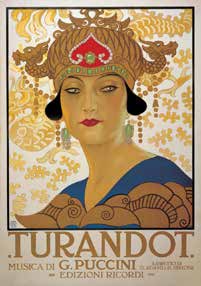Finding Turandot by Claudia Polzin, Independent Consultant

For Opera lovers Puccini’s Turandot is considered to be Puccini’s greatest opera. Puccini began working on Turandot in May of 1920 after meeting with librettists Giuseppe Adami and Renato Sioni. However, he became impatient waiting for the text and began the work on the opera himself. The name of the opera was derived from the Persian – Turandokht – a name frequently given to princesses in Persian poetry. Turan is a region in Central Asia that was once a contraction of dokhtar (daughter).
 Puccini strove for authenticity by using music from the region, even commissioning a set of 13 custom made gongs. Eight of the themes from the opera appear to be based on traditional Chinese music and anthems. By March of 1924 Puccini had completed the opera up to the final duet. He continued in October when the fourth version of the duet was chosen. However, two days later he was diagnosed with throat cancer. He planned to go to Brussels for treatment, but visited Arturo Toscanini and literally begged him saying: “Don’t let my Turandot die.” However, he died on November 29,1924 and never heard the opera performed. When he died the first two of three acts were completed and eventually Franco Alfano was chosen to finish the opera.
Puccini strove for authenticity by using music from the region, even commissioning a set of 13 custom made gongs. Eight of the themes from the opera appear to be based on traditional Chinese music and anthems. By March of 1924 Puccini had completed the opera up to the final duet. He continued in October when the fourth version of the duet was chosen. However, two days later he was diagnosed with throat cancer. He planned to go to Brussels for treatment, but visited Arturo Toscanini and literally begged him saying: “Don’t let my Turandot die.” However, he died on November 29,1924 and never heard the opera performed. When he died the first two of three acts were completed and eventually Franco Alfano was chosen to finish the opera.
When the opera premiered on April 25, 1926 at LaScala in Milan, Italy, Arturo Toscanini conducted. However, he ended the opera in the middle of Act III because that was where Puccini had ended his writing prior to his death. Reports claim that Toscanini said “where the opera ends, left incomplete by the death of poor Puccini” and the curtain was lowered. Subsequent performances include the end that was written by Alfano.
The synopsis of the story, which is set in China, tells the story of the cold Princess Turandot, who challenges her suitors to answer three riddles or face death. A prince from Tartary; Calaf falls in love with her and manages to solve the riddles. But Turandot is still reluctant to marry him, but he offers her a way out; if she can guess his name by dawn, he will die. The opera ends with Turandot learning his name and accepting his love.
Before you go to the Opera – being held on April 27 at 8 p.m. at Artis—Naples presented by Gulfshore Opera and the Naples Philharmonic Orchestra – see if you can solve the three riddles:
-What is born each night and dies at dawn.
-What flickers red and warm like a flame, yet is not fire.
-What is like ice, but burns like fire.
The most famous aria from the opera – is Nesum dorma – this aria is sung in the final act by Prince Calaf who hears the decree that no one in Peking will sleep until Turandot learns the name of her suitor. If she does not learn his name, everyone in the city will be killed. This aria is the most impressive of tenor arias in the operatic repertoire featuring an astronomically high top B at the climax of the work.
Adding to the excitement of this production is the role of Prince Calaf will be played by Leonid Shoshyn, dramatic tenor at Odessa National Opera in Ukraine. Gulfshore Opera is honored to provide his American debut in this beloved opera. Leonid was enjoying an international career in Europe when COVID hit, and then his homeland was invaded. Since then, Leonid has served 8 months active duty. When he returned to the beloved city of his birth, Odessa, he and his colleagues bravely continue to perform in the beautiful 19th century Odessa Opera house while the country is under attack.
Hope you will enjoy this beautiful opera and the opportunity to hear this very talented cast.




Leave a Reply
Want to join the discussion?Feel free to contribute!